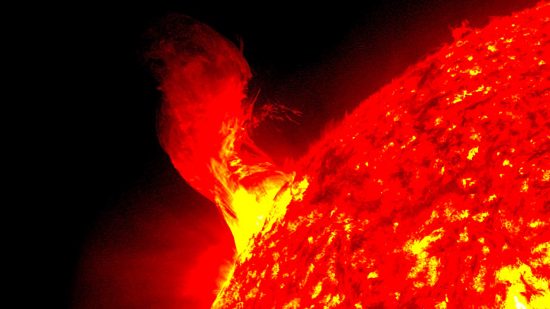
June 19, 2020
Astronomers believe that solar flares are caused by “magnetic reconnection events”.
“We all shine on…like the moon and the stars and the Sun…”
― John Lennon
A recent press release illustrates another of the more common ideas about the Sun. Using the thermonuclear fusion model of solar activity, astronomers think that solar flares are explosions that release an enormous amount of energy, equivalent to a trillion “Little Boy” atomic bombs exploding at the same time. In extreme cases, solar flares can disable radio connections and power stations on Earth, but they are also at the basis of stunning space weather phenomena. The Northern Lights, for instance, are linked to flares that disturb the Sun’s magnetic field.
As the press release states, “…we already understand quite a lot about the physical processes that take place during a solar flare. For one thing, we know that solar flares convert energy from magnetic fields into heat, light and motion energy very efficiently.”
The prevailing view is that the Sun accelerates charged particles away from its surface in the same way that sound waves are amplified. Pulsations in the photosphere are thought to travel along “magneto-acoustic wave-guides,” otherwise known as “magnetic flux tubes”. It is that kinetic effect that pushes “hot gas” outward.
In an Electric Universe, the Sun possesses a positive space charge sheath with respect to the interstellar medium (ISM). In other words, it is an anode terminal connected to galactic power circuits. Those circuits are of unknown length, and unknown potential, but they probably include influences that encompass thousands of cubic light-years. The electromagnetic energy moving through those galactic “transmission lines” is also unknown, but astronomers constantly report their amazement at the amount of energy released by solar flares.
It is not the intent of this article to challenge the magnetic reconnection model; that was done in several previous Pictures of the Day. Sufficient to say is that the Sun’s heliospheric boundary is a double layer “cocoon”, isolating it from galactic plasmas flowing through the Interstellar Medium. Voltage differences occur within the heliosphere, so the Sun experiences charge/discharge phenomena related to variable electrical input from the Milky Way. Therefore, sunspots and flares most likely derive from changes in its electrical supply, indicating variable input from its galactic circuit.
Solar flares could be like tremendous lightning bursts on the Sun, discharging matter at near relativistic speeds. The circuit that connects the Sun with the Milky Way might extend for hundreds, or even thousands of light-years. How much electrical energy is contained in those “transmission lines” feeding the solar anode can be understood by analyzing the electric potentials within the Sun’s sphere of influence.
Stephen Smith
The Thunderbolts Picture of the Day is generously supported by the Mainwaring Archive Foundation.












